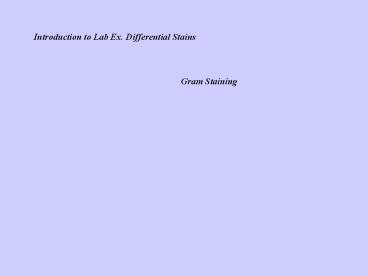Introduction to Lab Ex. Differential Stains - PowerPoint PPT Presentation
Title:
Introduction to Lab Ex. Differential Stains
Description:
Title: PowerPoint Presentation Author: S1S Last modified by: S1S Created Date: 10/16/2004 10:31:20 PM Document presentation format: On-screen Show Company – PowerPoint PPT presentation
Number of Views:26
Avg rating:3.0/5.0
Title: Introduction to Lab Ex. Differential Stains
1
Introduction to Lab Ex. Differential
Stains Gram Staining
2
Introduction to Lab Ex. Differential Stains
Gram Staining Basic classification of bacteria
is based on the cell wall structure. There are
2 main groups Gram positive and Gram negative.
Gram staining is a differential staining
technique that provides an easy differentiation
of bacteria into one of two groups. The
staining technique, developed in the late 1700s
by Christian Gram classifies the rigid cell
walled bacteria into one of two groups based on
whether they are able to resist the decolorizing
action of an alcoholic solution. Those that
resist decolorization by 95 ethanol are
arbitrarily termed Gram positive and those that
do not are Gram negative (the terms positive and
negative have nothing to do with charges of the
cell but based on differences in the cell wall
structure of these two groups of bacteria).
3
Gram-positive cell walls Gram-negative cell walls
The characteristic compound found in all true
bacterial cell walls is peptidoglycan. The
amount of PPG is among one of the differences
between the GP and GN cell walls.
- Thick peptidoglycan
- 90 peptidoglycan
- Teichoic acids
- 1 layer
- Not many polysaccharides
- In acid-fast cells, contains mycolic acid
- Thin peptidoglycan
- 5-10 peptidoglycan
- No teichoic acids
- 3 layers
- Outer membrane has lipids, polysaccharides
- No acid- fast cells (mycolic acid)
4
Figure 4.13b, c
5
The process includes the use of a primary stain
(crystal violet) a mordant (helper) iodine
solution, a decolorizer (95 ethanol), a
counterstain (safranin).
6
The Gram stain
Thin smear/heat fix Gram stain a. Flood
slide with crystal violet and let stain for 1
minute. b. Drain off crystal violet and rinse
off with distilled water flood slide with
Gram's iodine for 1 minute. c. Rinse off
Gram's iodine with distilled water. d. Hold
the slide on an angle (preferably with a
clothes pin) and drop 95 ethyl alcohol onto it
until the alcohol leaving the slide no longer
has a purple tint be sure to drop the alcohol
onto the upper portion of the slide so that the
smears are subjected to uniform decolorization.
Be careful not to "decolorize" dye from the
clothes pin!! e. Rinse with distilled water
and flood the slide with safranin and let stain
for 2-3 minutes. f. Rinse with distilled
water and blot dry with bibulous paper.
Gram positive
Gram negative
7
The crucial step in the staining process is the
decolorizing step. The most accepted theory
about the rationale for the Gram staining
process is the one proposed by Salton. This
theory relies on the fact that the PPG is found
in layers and the stain molecules are trapped
within the many layers of the GP CW when they
form the complex with the mordant Iodine
molecules. Since the GN CWs lack much PPG the
amount of stain captured in those CWs is much
lesser. When the cells are treated with the
decolorizer the ethanol this causes
denaturation of the proteins in the outer
membrane of the GN CWs resulting in gaping holes
in these CWs that lead to the removal of the
crystal violet-iodine complexes easily, leaving
these cells unstained. The counterstain
-safranin- thus is used to make these cells
visible.
8
There are 4 conditions to be followed for a valid
Gram staining procedure Young cultures -
must be young within 18-24hrs old (older
cultures lose their Gram staining properties
due to changes in the CWs as the cells get
older) Thin smear thicker or uneven smears
will result in uneven staining and
decolorization Fresh reagents - of proper
strength Control cultures - for a known GP
bacterium and GN culture (S.aureus E.coli)
9
Demos Gram stained slides of Neisseria,
Streptococcus, Pseudomonas, Actinomyces species.
Pseudomonas
Neisseria
Streptococcus

